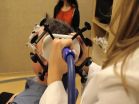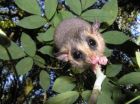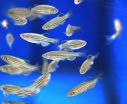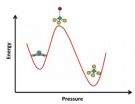(Press-News.org) Rabies (and rabies virus, its causative agent) is usually transmitted through the bite of an infected animal into muscle tissue of the new host. From there, the virus travels all the way to the brain where it multiplies and causes the usually fatal disease. An article published on August 28th in PLOS Pathogens sheds light on how the virus hijacks the transport system in nerve cells to reach the brain with maximal speed and efficiency.
Pathogens that travel in the blood can spread throughout the body without much effort, courtesy of the heart's pumping action. Those traveling outside the blood stream and needing to cover large distances—like rabies virus which depends on the nerve cell network—need to utilize other means of transport. Nerve cells (or neurons) in the periphery, i.e. the outskirts of the body, as opposed to the central nervous system or CNS), are highly asymmetric: they have a cell body from which a long protrusion called an axon extends to another nerve cell or a target organ like muscle, along a specific transmission route. Axons can measure several hundred times the diameter of the cell body, and, in addition to rapid transmission of electric impulses, they also transport molecular materials over these distances.
Rabies virus is known to somehow use this transport system, and Eran Perlson, from Tel Aviv University, Israel, and colleagues set out to examine the details of how this occurs. The researchers set up a system to grow asymmetric nerve cells in an observation chamber and use live cell imaging to track how rabies virus particles are transported along the axons.
They focused on the p75NTR receptor, a protein which is found on the tips of peripheral neurons and known to bind a small molecule called NGF (for nerve growth factor). When NGF binds p75NTR, both are taken up into the neuron and move in acidic bubbles called "vesicles" toward the cell body. The researchers found that rabies virus behaves very similar to NGF: it binds p75NTR, both are internalized, and subsequently found in acidic vesicles that move toward the nerve cell body.
Rabies virus is known to be able to infect neurons in the absence of p75NTR. However, when the researchers grew nerve cells that had no p75NTR in their observation chamber, they found that virus transport along the axon is less frequent and much slower. p75NTR-independent transport was also more erratic, with a larger proportion of viruses moving in the wrong direction, i.e. away from the cell body and towards the tip, suggesting that p75NTR facilitates the directed fast movement of the virus. When the researchers measured the speed of transport, they found that when rabies virus is transported with p75NTR, it moves at about 8 centimeters (a bit more than 3 inches) per day. Surprisingly, this is considerably faster (by about 40%) than the transport speed for NGF, the regular partner of p75NTR.
The authors summarize: "Our study shows that rabies virus can not only hijack the transport systems of the neuron, but might also manipulate the axonal transport machinery to facilitate its own arrival at the cell body, and from there to the central nervous system at maximum speed".
INFORMATION:
Please contact plospathogens@plos.org if you would like more information about our content and specific topics of interest.
All works published in PLOS Pathogens are open access, which means that everything is immediately and freely available. Use this URL in your coverage to provide readers access to the paper upon publication:
http://dx.plos.org/10.1371/journal.ppat.1004348 (Link goes live upon article publication)
Related Image for Press Use:
http://www.plos.org/wp-content/uploads/2013/05/Pathogens_Perlson_Aug28_IMG.jpg
Authors and Affiliations:
Shani Gluska, Tel Aviv University, Israel
Eitan Erez Zahavi, Tel Aviv University, Israel
Michael Chein, Tel Aviv University, Israel
Tal Gradus, Tel Aviv University, Israel
Anja Bauer, Friedrich-Loeffler-Institut, Institute of Molecular Virology and Cell Biology, Germany
Stefan Finke, Friedrich-Loeffler-Institut, Institute of Molecular Virology and Cell Biology, Germany
Eran Perlson, Tel Aviv University, Israel
From bite site to brain: How rabies virus hijacks and speeds up transport in nerve cells
2014-08-28
ELSE PRESS RELEASES FROM THIS DATE:
Genomic sequencing reveals mutations, insights into 2014 Ebola outbreak
2014-08-28
In response to an ongoing, unprecedented outbreak of Ebola virus disease (EVD) in West Africa, a team of researchers from the Broad Institute and Harvard University, in collaboration with the Sierra Leone Ministry of Health and Sanitation and researchers across institutions and continents, has rapidly sequenced and analyzed more than 99 Ebola virus genomes. Their findings could have important implications for rapid field diagnostic tests. The team reports its results online in the journal Science.
For the current study, researchers sequenced 99 Ebola virus genomes collected ...
Radio telescopes settle controversy over distance to Pleiades
2014-08-28
Astronomers have used a worldwide network of radio telescopes to resolve a controversy over the distance to a famous star cluster -- a controversy that posed a potential challenge to scientists' basic understanding of how stars form and evolve. The new work shows that the measurement made by a cosmic-mapping research satellite was wrong.
The astronomers studied the Pleiades, the famous "Seven Sisters" star cluster in the constellation Taurus, easily seen in the winter sky. The cluster includes hundreds of young, hot stars formed about 100 million years ago. As a nearby ...
New research reveals how wild rabbits were genetically transformed into tame rabbits
2014-08-28
The genetic changes that transformed wild animals into domesticated forms have long been a mystery. An international team of scientists has now made a breakthrough by showing that many genes controlling the development of the brain and the nervous system were particularly important for rabbit domestication. The study is published today in Science and gives answers to many genetic questions.
The domestication of animals and plants, a prerequisite for the development of agriculture, is one of the most important technological revolutions during human history. Domestication ...
Electric current to brain boosts memory
2014-08-28
VIDEO:
Stimulating a region in the brain with non-invasive electrical current using magnetic pulses (Transcranial Magnetic Stimulation) improves memory, reports a new Northwestern Medicine study in Science. The discovery opens...
Click here for more information.
CHICAGO --- Stimulating a particular region in the brain via non-invasive delivery of electrical current using magnetic pulses, called Transcranial Magnetic Stimulation, improves memory, reports a new Northwestern Medicine® ...
Less than $200 million would conserve precious Atlantic Forest in Brazil, say researchers
2014-08-28
Brazil could conserve its valuable Atlantic Forest by investing just 0.01 per cent of its annual GDP, according to a new study.
The Atlantic Forest (Mata Atlântica) is one of the most important and threatened biodiversity hotspots in the world, containing the only living examples of nearly 10,000 species of plant and more bird species than all of Europe.
Situated along the Atlantic coast of Brazil, it once covered an area of nearly 1.5 million square kilometres. Today, the forest is home to more than 130 million people and it covers only 160,000 km2, because of deforestation. ...
Home is where the microbes are
2014-08-28
A person's home is their castle, and they populate it with their own subjects: millions and millions of bacteria.
A study published today in Science provides a detailed analysis of the microbes that live in houses and apartments. The study was conducted by researchers from the U.S. Department of Energy's Argonne National Laboratory and the University of Chicago.
The results shed light on the complicated interaction between humans and the microbes that live on and around us. Mounting evidence suggests that these microscopic, teeming communities play a role in human ...
New DNA study unravels the settlement history of the New World Arctic
2014-08-28
We know people have lived in the New World Arctic for about 5,000 years. Archaeological evidence clearly shows that a variety of cultures survived the harsh climate in Alaska, Canada and Greenland for thousands of years. Despite this, there are several unanswered questions about these people: Where did they come from? Did they come in several waves? When did they arrive? Who are their descendants? And who can call themselves the indigenous peoples of the Arctic? We can now answer some of these questions, thanks to a comprehensive DNA study of current and former inhabitants ...
Penn-NIH team discover new type of cell movement
2014-08-28
VIDEO:
Penn and NIH researchers have demonstrated a never-before characterized type of cell movement. In this video, a cell's vimentin cytoskeleton (green) pulls the nucleus (red) forward to generate a high-pressure...
Click here for more information.
For decades, researchers have used petri dishes to study cell movement. These classic tissue culture tools, however, only permit two-dimensional movement, very different from the three-dimensional movements that cells make in a ...
How the zebrafish gets its stripes
2014-08-28
This news release is available in German. The zebrafish, a small fresh water fish, owes its name to a striking pattern of blue stripes alternating with golden stripes. Three major pigment cell types, black cells, reflective silvery cells, and yellow cells emerge during growth in the skin of the tiny juvenile fish and arrange as a multilayered mosaic to compose the characteristic colour pattern.
While it was known that all three cell types have to interact to form proper stripes, the embryonic origin of the pigment cells that develop the stripes of the adult fish has ...
Watching the structure of glass under pressure
2014-08-28
Glass has many applications that call for different properties, such as resistance to thermal shock or to chemically harsh environments. Glassmakers commonly use additives such as boron oxide to tweak these properties by changing the atomic structure of glass. Now researchers at the University of California, Davis, have for the first time captured atoms in borosilicate glass flipping from one structure to another as it is placed under high pressure.
The findings may have implications for understanding how glasses and similar "amorphous" materials respond at the atomic ...





